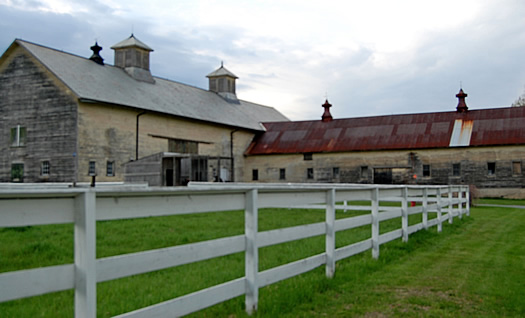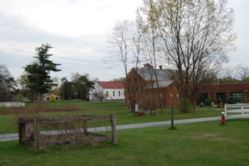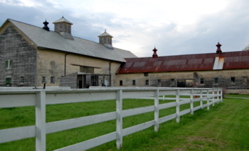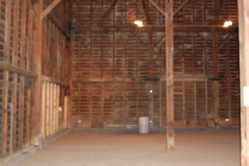A tour of the Shaker settlement in Colonie

America's first permanent Shaker settlement was founded in what was once Watervliet, and is now Colonie.
You might be familiar with the well-preserved and historic landmark Hancock Shaker Village in Western Massachusetts (not to mention its cute baby animals), but you might be surprised to find out the first American Shaker settlement was built right here in the Capital Region.
The Watervliet Shaker National Historical District, settled in 1776, is a stone's throw from Albany International Airport (it's right across Albany Shaker Road). Some of the site's buildings and the museum are open for self-guided tours, but lucky for me the Historic Albany Foundation and Shaker Heritage Society let me tag along on a recent and seldom-conducted guided tour.
It all started back in England in 1747. A woman named Ann Lee founded The United Society of Believers in Christ's Second Appearing (quite the mouthful), a Protestant sect known for its ecstatic worship dances, which gave the group its more common name - the Shakers. The Shakers believed anyone could communicate with God without the assistance of clergy, led their lives working hard in the pursuit of perfection and were famous for their adherence to celibacy.

Constant fighting between Protestants and Catholics at the time forced Ann Lee and some of her followers to flee to America, where they eventually settled in Colonie, mainly because the land -- then swampy -- was cheap. Ann Lee died in 1784 shortly after the site was settled (she is still buried there) but her fellow Shakers carried on her teachings.
The Colonie site was originally divided into four "families," or communities, each with its own responsibilities and members. While the Shakers drew a variety of followers -- singles, married couples, families -- most of the young members were orphaned children or children who were indentured to the Shakers to become skilled at a craft. Since Shakers were forbidden from having sexual relations, this was one method to gain young followers.
Today the only site open to the public (the others are privately owned) is the one once occupied by the Church family, which was made up of the long-term members and Shaker elders. The nonprofit Shaker Heritage Society cares for the buildings, although just nine remain -- when Albany County bought the land in 1925 there were 34 buildings, but many have since been destroyed.

The first stop on my tour was the Brethren's workshop, the oldest structure in the Church family site, constructed in 1822. The Shakers divvied up jobs according to gender and this building was the men's workshop. The original brickwork is typical of Shaker architecture, while the dormers and porch were added by the county. The Shakers were fond of color-coding their buildings and the yellow paint trim designates this one for work. While no original plans remain,the first floor of the building was used for dentistry work and skilled labor, such as carpentry and blacksmithing. The building was also later used as part of the site's preventorium, which isolated those infected with tuberculosis.

The barn is perhaps the most impressive building that remains at the site. Built in 1916 to house both hay and dairy cows, it was the second to last structure to be erected by the Shakers. According to my guide, building such a large structure so late in the settlement's history is a testament to the Shakers' hope and faith that they'd be able to gain new members (in its peak during the 1840s this settlement's population reached about 300).


The Shakers were known for their innovation and creativity and this barn is no exception. The wooden interior, tall and cathedral-like, was designed to herd the horses and oxen in one continual direction so the animals moved along in an orderly fashion without needing to back up. A manure shed is attached to the main barn by a metal beam, which helped slug the animal waste out in large quantities.


The last stop on our tour was the meeting house, which is one of the most in-tact of any preserved Shaker community. Built in 1848, the large white house with rich honey-toned wood floors was used by the Shakers during their religious dances, as there was ample space to gather and move about. The Shakers would often invite guests to observe their services from the dark wood observation pews and many important statesmen, including former governors and the entire New York state legislature, came to watch.

The room, built for sound and movement, has venerable acoustics and is still used for concerts today. The Shaker men and women would enter from separate sides wearing bright blue shoes and white formal wear -- blue and white being the colors of heaven. Then they would dance in a large circle, showcasing their unique jerking and twitching movements. Some of the dances can be reenacted today and although the Shakers had a unique music notation system, some songs are still popular (the hymn "Simple Gifts" was performed at President Obama's inauguration). Also on display in the meeting house are chairs hung upside down on the walls, which the Shakers did to facilitate sweeping, and triple-hung windows, a Shaker invention that allows for good ventilation and lighting as well as for glass to be washed from the inside.
Find It
Shaker Heritage Society
25 Meeting House Road
Albany, NY 12211
The museum and grounds are open Tuesday through Saturday from 9:30 a.m. to 4:00 p.m.
... said KGB about Drawing: What's something that brought you joy this year?